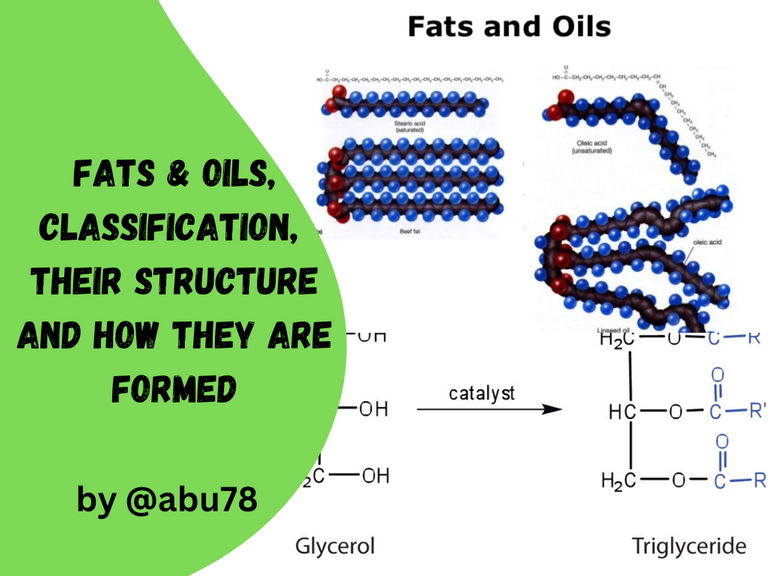Fats and oils, classification of fats and oils, the structure and how fats and oils are formed
Greetings to all and sundry on this platform once again. As a biochemistry student, today I did my research on "fats and oils, classification of fats and oils, the structure and how fats and oils are formed" and decided to share it with you guys here. I hope that you will enjoy it and also learn from it. Stay tuned with me as I discuss this topic in my article.

Fats and oils are a group of organic compounds composed of long hydrocarbon chains and small amounts of oxygen, nitrogen, Sulphur, and phosphorus. They are essential constituents of all living organisms, and they play an important role in many physiological processes.
Fats and oils have a variety of uses, both in the body and in the kitchen. Fats are essential for the absorption of fat-soluble vitamins, for insulating and cushioning organs, for providing energy, and for regulating body temperature. Oils contain essential fatty acids that are necessary for proper development and functioning of the body and the brain. In the kitchen, fats and oils are used as flavorings, ingredients, and cooking agents.
The structure of fats and oils is similar in that they are both composed of long hydrocarbon chains with small amounts of oxygen, nitrogen, Sulphur, and phosphorus. Moreover, they both have a triglyceride structure, which means that they have three fatty acids attached to a glycerol backbone. The length of the hydrocarbon chain and the degree of unsaturation determine the type of fat or oil.
Saturated fats have no double bonds in their hydrocarbon chains and are typically solid at room temperature. Examples of saturated fats include butter, lard, and tallow. Unsaturated fats have one or more double bonds in their hydrocarbon chains and are usually liquid at room temperature. Examples of unsaturated fats include olive oil, canola oil, and peanut oil.
Fats and oils are also classified by their origin. Animal fats include butter, lard, tallow, and suet. Plant-based oils include olive oil, canola oil, palm oil, soybean oil, and peanut oil. Some of these oils are further refined or partially hydrogenated in order to make them more suitable for baking and frying.
The importance of fats and oils in the body and in the kitchen is undeniable. Fats and oils play an important role in many physiological processes. Fats provide energy, insulate and cushion organs, and are necessary for the absorption of fat-soluble vitamins. Oils contain essential fatty acids that are necessary for proper development and functioning of the body and the brain.
In the kitchen, fats and oils are used as flavorings, ingredients, and cooking agents. Fats such as butter, lard, and tallow are used in baking, as spreadable fats, and as flavorings. Oils such as olive oil and peanut oil are used for cooking, as frying oils, and as salad dressings. Refined and partially hydrogenated fats and oils are often used for baking and frying.
Fats and oils are formed through the process of lipogenesis, which is the production of fat from carbohydrates. This process begins in the liver, where carbohydrates such as glucose are converted into fatty acids or glycerol. These fatty acids or glycerol are then packaged into droplets of fatty acids and glycerol, also known as triglycerides.
Triglycerides are then transported to other tissues in the body where they are used to store energy or serve as a building block for other molecules such as cholesterol or phospholipids. Triglycerides can also be broken down by lipases in the body to release fatty acids and glycerol, which can then be used for energy.
Fats and oils, then, are essential components of all living organisms. They play an important role in many physiological processes, and they are also used in the kitchen for a variety of purposes. Fats and oils are formed through the process of lipogenesis, and their structures are determined by the length of their hydrocarbon chain and the degree of unsaturation.
The references given below are sites where you can learn more about fats and oils.
Reference1
Reference2
Reference3
Reference4
Reference5

Congratulations @abu78! You have completed the following achievement on the Hive blockchain And have been rewarded with New badge(s)
Your next target is to reach 1750 upvotes.
Your next target is to reach 7000 upvotes.
You can view your badges on your board and compare yourself to others in the Ranking
If you no longer want to receive notifications, reply to this comment with the word
STOPTo support your work, I also upvoted your post!
Check out our last posts:
Support the HiveBuzz project. Vote for our proposal!
Fats from plants ( fat solubles) are really healthy to the body than any animal fats like soyabeans really rich and contain less fat.
Thus a nice introduction to types of fats and the formation processes, it made me reminiscence my days at the biochemistry lecture hall, interesting read, thanks for sharing
You always welcome, it is a pleasure sharing it here.
Thanks for your contribution to the STEMsocial community. Feel free to join us on discord to get to know the rest of us!
Please consider delegating to the @stemsocial account (85% of the curation rewards are returned).
Thanks for including @stemsocial as a beneficiary, which gives you stronger support.